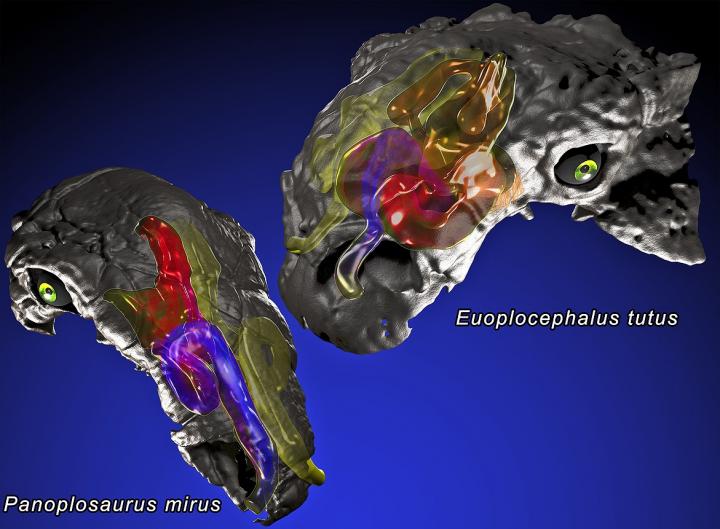Researchers used 3D computer modeling to simulate heat exchange in dinosaurs

Credit: Jason Bourke, Ph.D., NYITCOM at A-State
JONESBORO, AR; December 19, 2018–Researchers have long wondered how gigantic, heavily armored dinosaurs, such as the club-tailed ankylosaurs that lived in sweltering climates, avoided overheating. While their large bodies were adept at retaining heat, their sheer size created a heat-shedding problem that would have put them at risk of overheating, even on cloudy days. In the absence of a protective cooling mechanism, the delicate neural tissue of their brains could be damaged by the hot blood from the core of their bodies.
Now, as seen in the December 19 issue of PLOS ONE, researchers, led by a paleontologist from New York Institute of Technology College of Osteopathic Medicine at Arkansas State University (NYITCOM at A-State), have posed a new theory–the dinosaurs had an intricate cooling system in their snouts.
“The large bodies of many dinosaurs must have gotten very hot in warm Mesozoic climates, and we’d expect their brains to adapt poorly to these conditions. With that in mind, we wanted to see if there were ways to protect the brain from ‘cooking.’ It turns out the nose may be the key, and likely housed a ‘built-in air conditioner,'” said Jason Bourke, Ph.D., assistant professor of basic sciences, NYITCOM at A-State, and lead author of the study.
According to the researchers, smell may be a primary function of the nose, but noses are also important heat exchangers, ensuring that air is warmed and humidified before it reaches the delicate lungs. To accomplish this effective air conditioning, birds and mammals–including humans–rely on thin curls of bone and cartilage within their nasal cavities, called turbinates, which increase the surface area and allow for air to come into greater contact with the nasal walls.
The team used Computed Tomography (CT) scanning and a powerful engineering modeling approach called computational fluid dynamics to simulate how air moved through the nasal passages of two different ankylosaur species, the hippo-sized Panoplosaurus and larger rhino-sized Euoplocephalus. These tests examined how well ankylosaur noses transferred heat from the body to the inhaled air. The researchers found that ankylosaurs lacked turbinates, and instead evolved to have longer, coiled noses. Despite this strange anatomy, these noses were just as efficient at warming and cooling respired air.
“A decade ago, my colleague and I published the discovery that ankylosaurs had extremely long nasal passages coiled up in their snouts,” said study co-author Lawrence Witmer, professor of anatomy, Ohio University Heritage College of Osteopathic Medicine. “These convoluted airways resembled a child’s ‘crazy-straw’–completely unexpected and seemingly without reason, until now.”
In Panoplosaurus, the nasal passages were a bit longer than the skull itself, and in Euoplocephalus they were almost twice as long as the skull, as well as coiled up the snout. To see if nasal passage length was the reason for this efficiency, Bourke ran alternative models with shorter, simpler nasal passages that ran directly from the nostril to the throat, as in most other animals. The results clearly showed that nose length was indeed the key to their air-conditioning ability.
“When we stuck a short, simple nose in their snouts, heat-transfer rates dropped by over 50% in both dinosaurs. They were less efficient and didn’t work very well,” said Bourke.
Another line of evidence that these noses were air conditioners that helped cool the brain came from analyses of blood flow. When blood vessels were reconstructed, based on bony grooves and canals, the team found a rich blood supply running right next to these convoluted nasal passages. According to Ruger Porter, lecturer at the Ohio University Heritage College of Osteopathic Medicine and another of the study’s co-authors, hot blood from the body core would travel through these blood vessels and transfer their heat to the incoming air. Simultaneously, evaporation of moisture in the long nasal passages cooled the venous blood destined for the brain.
The complicated nasal airways of these dinosaurs were acting as radiators to cool down the brain with a constant flow of cooled venous blood, allowing them to keep a cool head at all times. This natural engineering feat also may have allowed the evolution of the great sizes of so many dinosaurs.
“This project is an excellent example of how advances in CT scanning, 3-D reconstruction, imaging, and computational fluid dynamics modeling can be used in biological research to test long-standing hypotheses,” said Kathy Dickson, a program officer at the National Science Foundation (NSF) that funded the research. “From these new images and models, fossils can provide further insight into extinct organisms like the ankylosaur – in this case, offering an explanation of how unusual features actually function physiologically.”
###
The next step for the researchers is to examine other dinosaurs to determine when this nasal enlargement happened. For more information about NYITCOM at A-State, visit nyit.edu/Arkansas.
The research was funded by NSF grants to Witmer and an NSF fellowship to Bourke, as well as by the Ohio University Heritage College of Osteopathic Medicine.
About NYITCOM at A-State
New York Institute of Technology College of Osteopathic Medicine at Arkansas State University (NYITCOM at A-State) is located in Jonesboro, AR, on the campus of Arkansas State University. Medical degrees are conferred by NYIT, a private, non-profit institution of higher education that established its medical school (NYITCOM) program in Jonesboro to meet the need for more physicians in this medically underserved area. Upon welcoming its inaugural class of 115 medical students in August 2016, NYITCOM at A-State began delivering on its mission to improve access to health care for the underserved and rural populations in the Mississippi Delta Region.
Media Contact
Kim Tucker
[email protected]
516-686-4013
Original Source
http://www.
Related Journal Article
http://dx.




